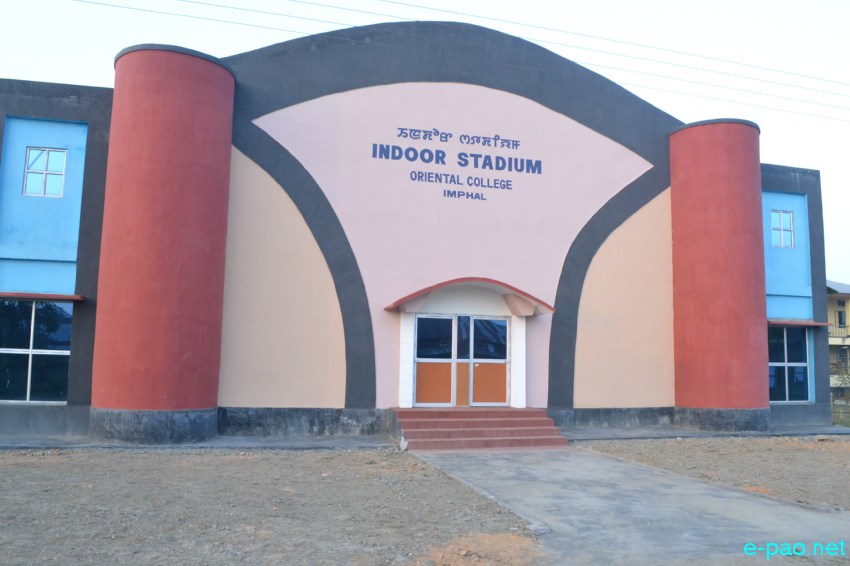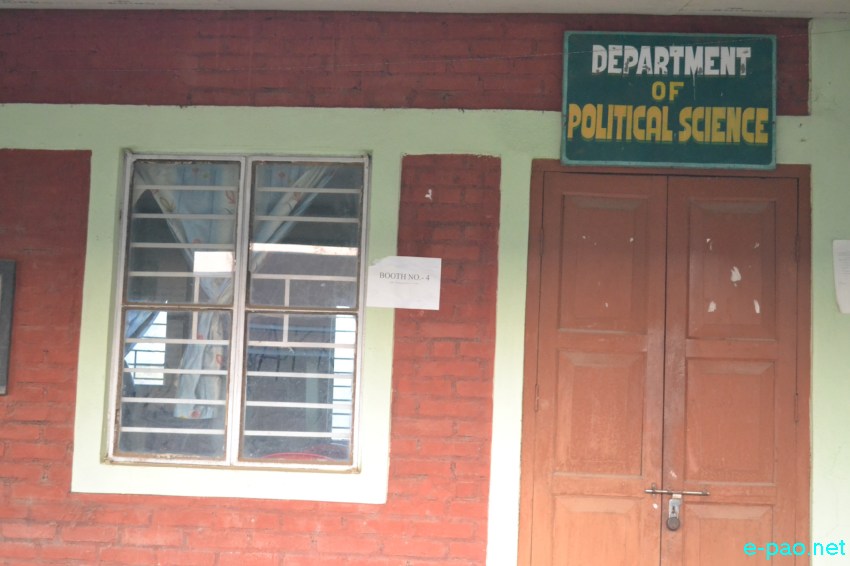
Oriental College in Imphal in December 2013 :: Pix - Ashok Ningthoujam
Experience and Experiments with Online Teaching in a Pandemic-Affected World
Biplob Kongkham *

Oriental College in Imphal in December 2013 :: Pix - Ashok Ningthoujam
Technological innovations influence the pace of social progress and often shape the trajectory of educational systems and their pedagogical patterns. Concepts like Open and Distance Learning (ODL) and Massive Open Online Courses (MOOCs) have recently gained widespread attention and usage.
Web-based Open Educational Resources (OERs) and online learning in general have carved their niche in the domain of contemporary education. The unprecedented magnitude of the Covid-19 pandemic making governments worldwide impose lockdowns as control measures led to widespread closure of educational institutions. This caused an obvious shift from the usual classroom-based learning to almost exclusively virtual or online education.
This article is an anecdotal account of the quantum leap from traditional to online teaching-learning at Oriental College, Imphal, the first autonomous college in Manipur. Located in the rural precincts of Imphal West district, the college started going online since May 2020 after a nationwide lockdown was called to contain Covid-19.
Since then, the cumulative experience for both the institution and the Department of Political Science (to which the writer belongs) has been undeniably enriching. A narrative analysis is made here to reflect on the multidimensional aspects of online education from a personal and experiential viewpoint.
From Rudimentary Origins to Stable Systems
In May 2020, circumstantially compelled amidst looming uncertainties, online classes for three even semesters in the Department of Political Science made a modest outset through Zoom Cloud Meetings. Despite its user-friendly interface, Zoom was quickly abandoned and replaced with Google Meet because of the former's privacy and security concerns.
Google tools have the advantage of inter-linkage and interoperability across its various workspace platforms including Gmail, Google Drive, Google Forms, Google Classroom etc. Moreover, its free versions can easily cater to multiple needs of relatively smaller class sizes of 30 to 50 learners. Hence, Google Meet and other Google tools became the stable platform of choice for online classes.
Initially, there was substantial inclination towards lecture method for content delivery through online teaching. It however quickly gave way to a highly interactive and bi-directional learning process with rigorous emphasis on student activity and creativity. This was necessitated, among other things, by the institution's existing Choice Based Credit System (CBCS) and Continuous Internal Assessments (CIA).
Components of CIA like unit tests, quiz, group discussion, term paper assignments, seminar presentation and project work constitute 40 percent of end-semester evaluation. All these were incorporated with relative ease in online learning whose strengths lie in its 'smart' characteristics - enabled by audio-visual interconnectedness and unlimited linkage with web resources.
Managing the Shift to a Virtual Plane
With some prior experimentation in smart classes and blended learning, the shift to online modes of teaching wasn't entirely uncharted. Apart from the institutional website, WhatsApp study groups for each class were created to share relevant information. Preparing a routine one-hour online class usually commences with a pre-formulated teaching plan detailing specific objectives and learning outcomes for each lesson and topic.
Relevant study materials including Pdf files and weblinks are shared before each class. Once classes begin, instructional strategies revolve around tailored PowerPoint slides incorporating strong visual cues. Students thoroughly enjoy and benefit from an infinite array of up-to-date and real-time examples related to the topic of study. These include easy manoeuvres across different references, statistical data, images and videos readily available on the internet. Ten minutes are dedicated at the end of every class to clear doubts and share feedback from the students.
In July 2021, Manipur's Department of Higher Education took up the best and boldest step in streamlining and rationalizing online education through a centralized state-wide introduction of Modular Object-Oriented Dynamic Learning Environment (MOODLE) Learning Management System (LMS). While online classes have been conducted individually in different platforms, MOODLE LMS ensured uniformity and greater scope for effective monitoring and evaluation of online teaching.
Much more feature-rich compared to Google Classroom, MOODLE's user interface more than suffices the multidimensional needs of undergraduate education. Online class Permalinks, timed attendance records, multiple file uploads, assignments and tests, automated and manual grading, announcements etc. constitute only a few of the grand virtual classroom that MOODLE is. Since its introduction, its relative ease of use and individualized experience has rendered it extremely popular among learners and teachers alike.
Almost all internal assessments and instructional materials including certain aspects of e-governance are fulfilled successfully through MOODLE.

Oriental College in Imphal in December 2013 :: Pix - Ashok Ningthoujam
Blending Pedagogies and Ensuring Effectiveness
Teaching is a solemn act requiring sincere dedication and sound strategies to realize optimal outcomes. As such, the teacher must be sensibly flexible in adopting pedagogical philosophies. Hence, a blend of traditional, constructivist and collaborative pedagogies were applied; preferring one over the other under specific demands of the learning situation.
Under the traditional approach, reliance is upon lectures, seminar presentations and provision of texts and other study materials. Under constructivist pedagogy, students are tasked with self-instruction through rigorous study of materials provided in MOODLE and they are required to answer specific topic-related questions.
They are also encouraged to adopt collaborative learning through a multitude of learning components including preparation of group Project Reports, Presentations, Quizzes and Group Discussions. Assessment and evaluation requiring teamwork is open and sometimes peer reviewed with an eye on greater participation and healthy competition among learners. This has led to tangible improvements in team spirit, leadership and communication skills.
Holistic feedback on effectiveness of online learning is often sought from students in questionnaires administered through Google Forms. Quite interestingly, there has been overwhelmingly positive response from students indicating higher interest in learning, greater access to educational resources, improved computing and problem-solving skills.
Attendance and pass percentages have soared compared to classroom-based teaching. Reliance on multiple web resources other than static textbooks ensure acquaintance with latest developments in the discipline. This was also supplemented effectively by enrolling students in the institutional N-LIST (National Library and Informational Services Infrastructure for Scholarly Content) account.
In June 2021, successive 'Student Webinars' were conducted to introduce the department's students to MOOCs (like Coursera, edX, Udemy, FutureLearn and Swayam). Nearly 80 students successfully completed two micro-credential courses in July 2021 through FutureLearn and almost the same number enrolled in Swayam for different courses. This is an extremely engaging and inspiring experience for the students of the department, many of whom hail from economically weaker backgrounds.
In spite of its manifold advantages, online learning is still susceptible to different shortcomings in varying degrees. Manipur being a hilly state, there are lingering electricity, connectivity and bandwidth issues that limit effective online teaching. Nearly 60 percent of the department's total students hail from the hill districts of Manipur.
Nevertheless, only a handful face occasional access problems which are also addressed through selective mechanisms adopted in MOODLE LMS. Advanced and slow learners are carefully segregated and curative measures including remedial classes and personal counselling have been adopted.
All-inclusive virtual classrooms and study groups also ensure that student activity and progression can be monitored and guided in all stages of their course. This applies beyond routine classes to aspects like extracurricular activities, career counselling, admissions and examinations guidance.
Conclusion
The sudden shift to online learning from May 2020 in Oriental College, Imphal was a direct outcome of restrictions following the Covid-19 pandemic. While the long-term effects of this drastic step are yet to be fully understood, it has, in many ways become a blessing in disguise for both teachers and students.
For an undergraduate college in a rural setting catering to students from remote corners of the state, this transformation has enabled extensive integration of information and communication technology with traditional learning patterns. Exposed to some of the best learning resources, students have also inculcated key soft skills and learning techniques, both by choice and compulsion.
There is widespread consensus that the online can never fully replace the offline in education. However, even in a futuristic post-pandemic scenario, a blended approach that integrates the benefits of both will go a long way in enriching learning experience of students.